Fine Litter Dynamics in Tropical Dry Forests Located in Two Contrasting Landscapes of the Colombian Caribbean
Abstract
1. Introduction
2. Materials and Methods
2.1. Study Area
2.2. Sampling Design and Monitoring
2.3. Data Analyses and Processing
2.4. Climatic Data
3. Results
3.1. Annual Fine Litterfall
3.2. Litterfall Seasonality
4. Discussion
4.1. Annual Fine Litterfall
4.2. Litterfall Seasonality
5. Conclusions
Author Contributions
Funding
Data Availability Statement
Acknowledgments
Conflicts of Interest
References
- Van Veen, J.A.; Liljeroth, E.; Lekkerkerk, L.J.A.; Van De Geijn, S.C. Carbon Fluxes in Plant-Soil Systems at Elevated Atmospheric CO2 Levels. Ecol. Appl. 1991, 1, 175–181. [Google Scholar] [CrossRef] [PubMed]
- Ontl, T.; Schulte, L.A. Soil Carbon Storage. Nat. Educ. Knowl. 2012, 3, 35. [Google Scholar]
- Wei, X.; Shao, M.; Gale, W.; Li, L. Global pattern of soil carbon losses due to the conversion of forests to agricultural land. Sci. Rep. 2015, 4, 4062. [Google Scholar] [CrossRef] [PubMed]
- Phillips, J.; Ramirez, S.; Wayson, C.; Duque, A. Differences in carbon stocks along an elevational gradient in tropical mountain forests of Colombia. Biotropica 2019, 51, 490–499. [Google Scholar] [CrossRef]
- González-M, R.; García, H.; Isaacs, P.; Cuadros, H.; López-Camacho, R.; Rodríguez, N.; Pérez, K.; Mijares, F.; Castaño-Naranjo, A.; Jurado, R.; et al. Disentangling the environmental heterogeneity, floristic distinctiveness and current threats of tropical dry forests in Colombia. Environ. Res. Lett. 2018, 13, 045007. [Google Scholar] [CrossRef]
- Becknell, J.M.; Kissing Kucek, L.; Powers, J.S. Aboveground biomass in mature and secondary seasonally dry tropical forests: A literature review and global synthesis. For. Ecol. Manag. 2012, 276, 88–95. [Google Scholar] [CrossRef]
- Moonlight, P.W.; Banda-R, K.; Phillips, O.L.; Dexter, K.G.; Pennington, R.T.; Baker, T.R.; de Lima, H.C.; Fajardo, L.; González-M, R.; Linares-Palomino, R.; et al. Expanding tropical forest monitoring into Dry Forests: The DRYFLOR protocol for permanent plots. Plants People Planet 2021, 3, 295–300. [Google Scholar] [CrossRef]
- Barliza, J.C.; Rodríguez, O.B.; Peláez, J.D.L.; Chávez, L.F. Planted forests for open coal mine spoils rehabilitation in Colombian drylands: Contributions of fine litterfall through an age chronosequence. Ecol. Eng. 2019, 138, 180–187. [Google Scholar] [CrossRef]
- Calvo-rodriguez, S.; Arturo, G.S.; Dur, S.M.; Marcos, M.; Esp, D.; Roberta, Y.; Nunes, F. Dynamics of Carbon Accumulation in Tropical Dry Forests under Climate Change Extremes. Forests 2021, 12, 106. [Google Scholar] [CrossRef]
- Johnson, D.W.; Turner, J. Tamm Review: Nutrient cycling in forests: A historical look and newer developments. For. Ecol. Manag. 2019, 444, 344–373. [Google Scholar] [CrossRef]
- Van Langenhove, L.; Verryckt, L.T.; Bréchet, L.; Courtois, E.A.; Stahl, C.; Hofhansl, F.; Bauters, M.; Sardans, J.; Boeckx, P.; Fransen, E.; et al. Atmospheric deposition of elements and its relevance for nutrient budgets of tropical forests. Biogeochemistry 2020, 149, 175–193. [Google Scholar] [CrossRef]
- Sayer, E.J.; Rodtassana, C.; Sheldrake, M.; Bréchet, L.M.; Ashford, O.S.; Lopez-Sangil, L.; Kerdraon-Byrne, D.; Castro, B.; Turner, B.L.; Wright, S.J.; et al. Revisiting nutrient cycling by litterfall—Insights from 15 years of litter manipulation in old-growth lowland tropical forest. In Advances in Ecological Research; Academic Press: Cambridge, MA, USA, 2020; Volume 62, pp. 173–223. [Google Scholar]
- León-Peláez, J.D.; de Colombia, U.N.; Caicedo-Ruiz, W.; Castellanos-Barliza, J.; de Colombia, S.M.U.N.; del Magdalena, U. Reactivation of nutrient cycling in an urban tropical dry forest after abandonment of agricultural activities. Rev. Chapingo Ser. Cienc. For. 2021, 27, 355–365. [Google Scholar] [CrossRef]
- Williams-Linera, G.; Bonilla-Moheno, M.; López-Barrera, F.; Tolome, J. Litterfall, vegetation structure and tree composition as indicators of functional recovery in passive and active tropical cloud forest restoration. For. Ecol. Manag. 2021, 493, 119260. [Google Scholar] [CrossRef]
- Barliza, J.C.; Peláez, J.D.L.; Campo, J. Recovery of biogeochemical processes in restored tropical dry forest on a coal mine spoil in La Guajira, Colombia. Land Degrad. Dev. 2018, 29, 3174–3183. [Google Scholar] [CrossRef]
- Liu, X.; Zhou, T.; Luo, H.; Xu, P.; Gao, S.; Liu, J. Models ignoring spatial heterogeneities of forest age will significantly overestimate the climate effects on litterfall in China. Sci. Total Environ. 2019, 661, 492–503. [Google Scholar] [CrossRef] [PubMed]
- González-Rodríguez, H.; Domínguez-Gómez, T.G.; Silva, I.C.; Gómez-Meza, M.V.; Ramírez-Lozano, R.G.; Pando-Moreno, M.; Fernández, C.J. Litterfall deposition and leaf litter nutrient return in different locations at Northeastern Mexico. Plant Ecol. 2011, 212, 1747–1757. [Google Scholar] [CrossRef]
- Lawrence, D. Regional-Scale Variation in Litter Production and Seasonality in Tropical Dry Forests of Southern Mexico1. Biotropica 2005, 37, 561–570. [Google Scholar] [CrossRef]
- Morffi-Mestre, H.; Ángeles-Pérez, G.; Powers, J.S.; Andrade, J.L.; Ruiz, A.H.H.; May-Pat, F.; Chi-May, F.; Dupuy, J.M. Multiple Factors Influence Seasonal and Interannual Litterfall Production in a Tropical Dry Forest in Mexico. Forests 2020, 11, 1241. [Google Scholar] [CrossRef]
- Souza, S.R.; Veloso, M.D.M.; Espírito-Santo, M.M.; Silva, J.O.; Sánchez-Azofeifa, A.; Souza e Brito, B.G.; Fernandes, G.W. Litterfall dynamics along a successional gradient in a Brazilian tropical dry forest. For. Ecosyst. 2019, 6, 6. [Google Scholar] [CrossRef]
- Elias, D.M.O.; Robinson, S.; Both, S.; Goodall, T.; Majalap-Lee, N.; Ostle, N.; McNamara, N.P. Soil Microbial Community and Litter Quality Controls on Decomposition Across a Tropical Forest Disturbance Gradient. Front. For. Glob. Chang. 2020, 3, 81. [Google Scholar] [CrossRef]
- MinAmbiente. Available online: http://www.siac.gov.co/catalogo-de-mapas (accessed on 17 December 2021).
- De Chant, T.; Gallego, A.H.; Saornil, J.V.; Kelly, M. Urban influence on changes in linear forest edge structure. Landsc. Urban Plan. 2010, 96, 12–18. [Google Scholar] [CrossRef]
- Wang, Q.; Li, F.; Zhao, X.; Zhao, W.; Zhang, D.; Zhou, X.; Sample, D.J.; Wang, X.; Liu, Q.; Li, X.; et al. Runoff and nutrient losses in alfalfa (Medicago sativa L.) production with tied-ridge-furrow rainwater harvesting on sloping land. Int. Soil Water Conserv. Res. 2021; in press. [Google Scholar] [CrossRef]
- Bin, L.; Xu, K.; Xu, X.; Lian, J.; Ma, C. Development of a landscape indicator to evaluate the effect of landscape pattern on surface runoff in the Haihe River Basin. J. Hydrol. 2018, 566, 546–557. [Google Scholar] [CrossRef]
- Jaramillo, D. El suelo: Origen, Propiedades, Espacialidad. Universidad Nacional de Colombia, Sede Medellín, Facultad de Ciencias, Escuela de Geociencias: Medellín, Colombia. 2014; in press. 161–191. [Google Scholar]
- IDEAM, Instituto de Hidrología, Meteorología y Estudios Ambientales. Available online: http://dhime.ideam.gov.co/atencionciudadano/ (accessed on 7 December 2021).
- Funk, C.; Peterson, P.; Landsfeld, M.; Pedreros, D.; Verdin, J.; Shukla, S.; Husak, G.; Rowland, J.; Harrison, L.; Hoell, A.; et al. The climate hazards infrared precipitation with stations—A new environmental record for monitoring extremes. Sci. Data 2015, 2, 150066. [Google Scholar] [CrossRef] [PubMed]
- Osborne, B.B.; Soper, F.M.; Nasto, M.K.; Bru, D.; Hwang, S.; Machmuller, M.B.; Morales, M.L.; Philippot, L.; Sullivan, B.W.; Asner, G.P.; et al. Litter inputs drive patterns of soil nitrogen heterogeneity in a diverse tropical forest: Results from a litter manipulation experiment. Soil Biol. Biochem. 2021, 158, 108247. [Google Scholar] [CrossRef]
- Chave, J.; Navarrete, D.; Almeida, S.; Álvarez, E.; Aragão, L.E.O.C.; Bonal, D.; Châtelet, P.; Silva-Espejo, J.E.; Goret, J.-Y.; von Hildebrand, P.; et al. Regional and seasonal patterns of litterfall in tropical South America. Biogeosciences 2010, 7, 43–55. [Google Scholar] [CrossRef]
- Campo, J.; Merino, A. Linking organic P dynamics in tropical dry forests to changes in rainfall regime: Evidences of the Yucatan Peninsula. For. Ecol. Manag. 2019, 438, 75–85. [Google Scholar] [CrossRef]
- Machado, D.L.; Engel, V.L.; Podadera, D.S.; Sato, L.M.; de Goede, R.G.M.; de Moraes, L.F.D.; Parrotta, J.A. Site and plant community parameters drive the effect of vegetation on litterfall and nutrient inputs in restored tropical forests. Plant Soil 2021, 464, 405–421. [Google Scholar] [CrossRef]
- Castellanos-Barliza, J.; Peláez, J.D.L.; Armenta-Martínez, R.; Barranco-Pérez, W.; Caicedo-Ruíz, W. Contributions of organic matter and nutrients via leaf litter in an urban tropical dry forest fragment. Rev. Biol. Trop. 2018, 66, 571–585. [Google Scholar] [CrossRef]
- León, J.D.; Osorio, N.W. Role of Litter Turnover in Soil Quality in Tropical Degraded Lands of Colombia. Sci. World J. 2014, 2014, 693981. [Google Scholar] [CrossRef] [PubMed]
- Martínez-Yrízar, A.; Sarukhán, J. Litterfall patterns in a tropical deciduous forest in Mexico over a five-year period. J. Trop. Ecol. 1990, 6, 433–444. [Google Scholar] [CrossRef]
- Maya, Y.; Arriaga, L. Litterfall and phenological patterns of the dominant overstorey species of a desert scrub community in north-western Mexico. J. Arid Environ. 1996, 34, 23–35. [Google Scholar] [CrossRef]
- Sundarapandian, S.; Swamy, P. Litter Production and Leaf-Litter Decomposition of Selected Tree. For. Ecol. Manag. 1999, 123, 231–244. [Google Scholar] [CrossRef]
- De Queiroz, M.G.; da Silva, T.G.F.; Zolnier, S.; de Souza, C.A.A.; de Souza, L.S.B.; Neto, A.J.S.; de Araújo, G.G.L.; Ferreira, W.P.M. Seasonal patterns of deposition litterfall in a seasonal dry tropical forest. Agric. For. Meteorol. 2019, 279, 107712. [Google Scholar] [CrossRef]
- Dutta, R.K.; Agrawal, M. Litterfall, litter decomposition and nutrient release in five exotic plant species planted on coal mine spoils. Pedobiologia 2001, 45, 298–312. [Google Scholar] [CrossRef]
- Descheemaeker, K.; Muys, B.; Nyssen, J.; Poesen, J.; Raes, D.; Haile, M.; Deckers, J. Litter production and organic matter accumulation in exclosures of the Tigray highlands, Ethiopia. For. Ecol. Manag. 2006, 233, 21–35. [Google Scholar] [CrossRef]
- Collantes Quintero, A.; Castellanos-Barliza, J.; Leon Pelaez, J.D.; Tamaris-Turizo, C.E. Characterization of the Organic Matter Provided by Leaf Litter in the Forest in the Gaira Riverbank (Sierra Nevada de Santa Marta-Colombia). Rev. Investig. Agrar. Y Ambient. 2014, 5, 171–184. [Google Scholar] [CrossRef][Green Version]
- Ibrahima, A.; Ntonga, J.C.; Mvondo Ze, A.D. Litterfall, litter standing crops and nutrient dynamics as influenced by selective logging in tropical rainforest of Ebom, Southwest Cameroon. J. Ecol. Nat. Environ. 2018, 10, 205–220. [Google Scholar] [CrossRef]
- Lopezaraiza-Mikel, M.; Quesada, M.; Álvarez-Añorve, M.; Ávila-Cabadilla, L.; Martén-Rodríguez, S.; Calvo-Alvarado, J.; do Espírito-Santo, M.M.; Fernandes, G.W.; Sánchez-Azofeifa, A.; de Jesús Aguilar-Aguilar, M.; et al. Phenological Patterns of Tropical Dry Forests along Latitudinal and Successional Gradients in the Neotropics. In Tropical Dry Forests in the Americas; CRC Press: Boca Raton, FL, USA, 2014; pp. 119–146. [Google Scholar]
- Villalobos, C.; González-Carcacía, J.A.; Rodríguez, J.P.; Nassar, J. Interspecific and Interannual Variation in Foliar Phenological Patterns in a Successional Mosaic of a Dry Forest in the Central Llanos of Venezuela. In Tropical Dry Forests in the Americas; CRC Press: Boca Raton, FL, USA, 2014; pp. 301–327. [Google Scholar]
- Murphy, P.G.; E Lugo, A. Ecology of Tropical Dry Forest. Annu. Rev. Ecol. Syst. 1986, 17, 67–88. [Google Scholar] [CrossRef]
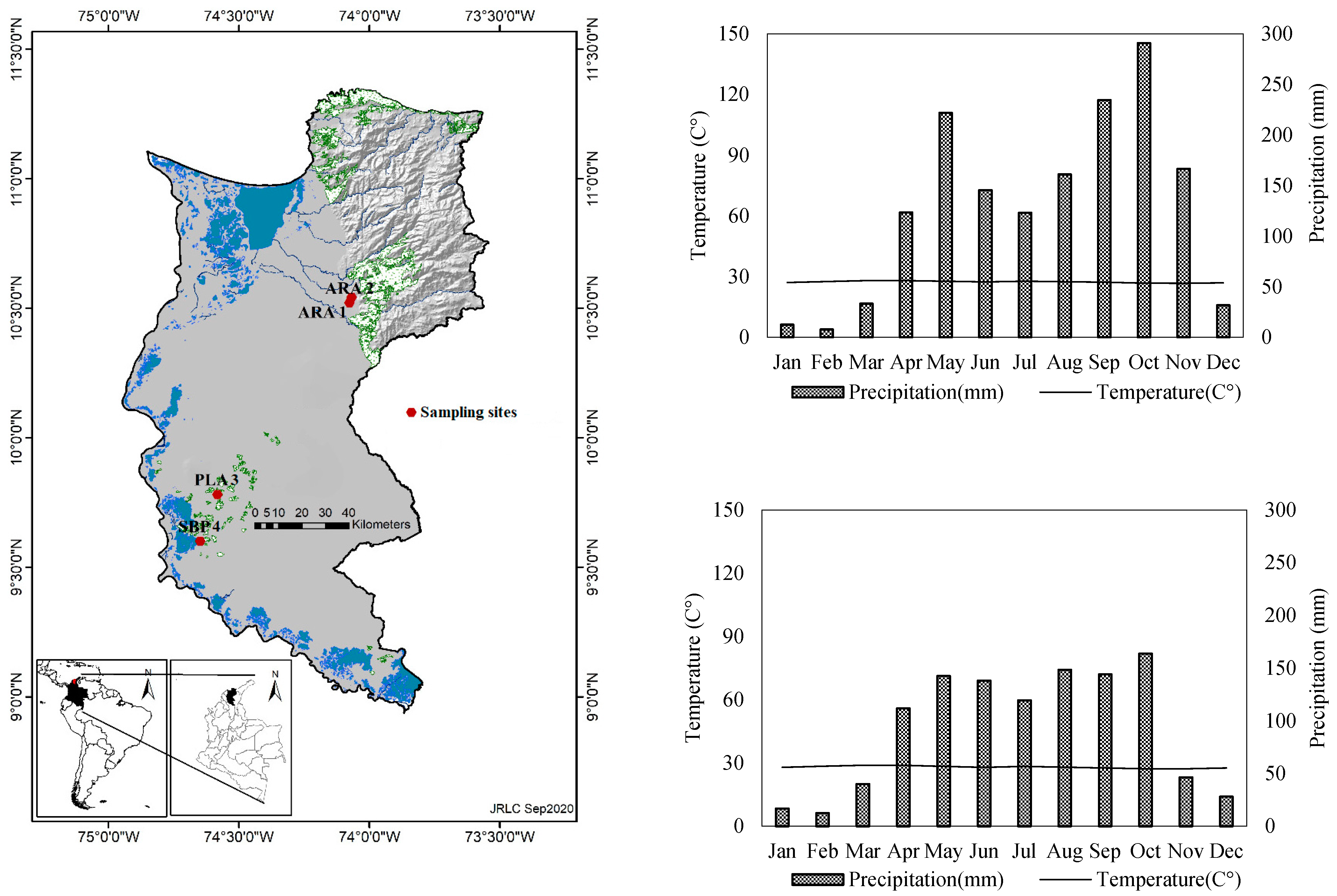
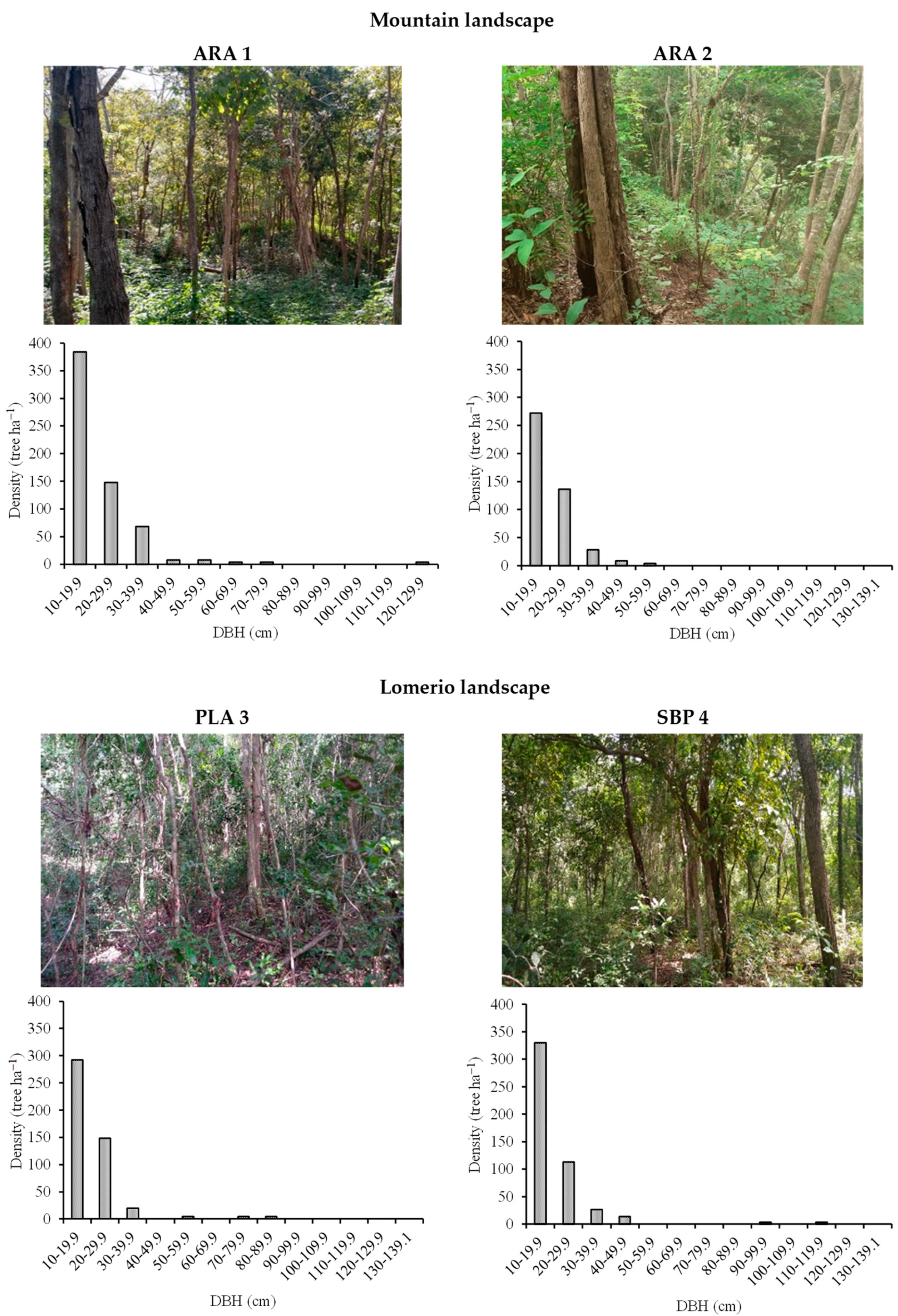
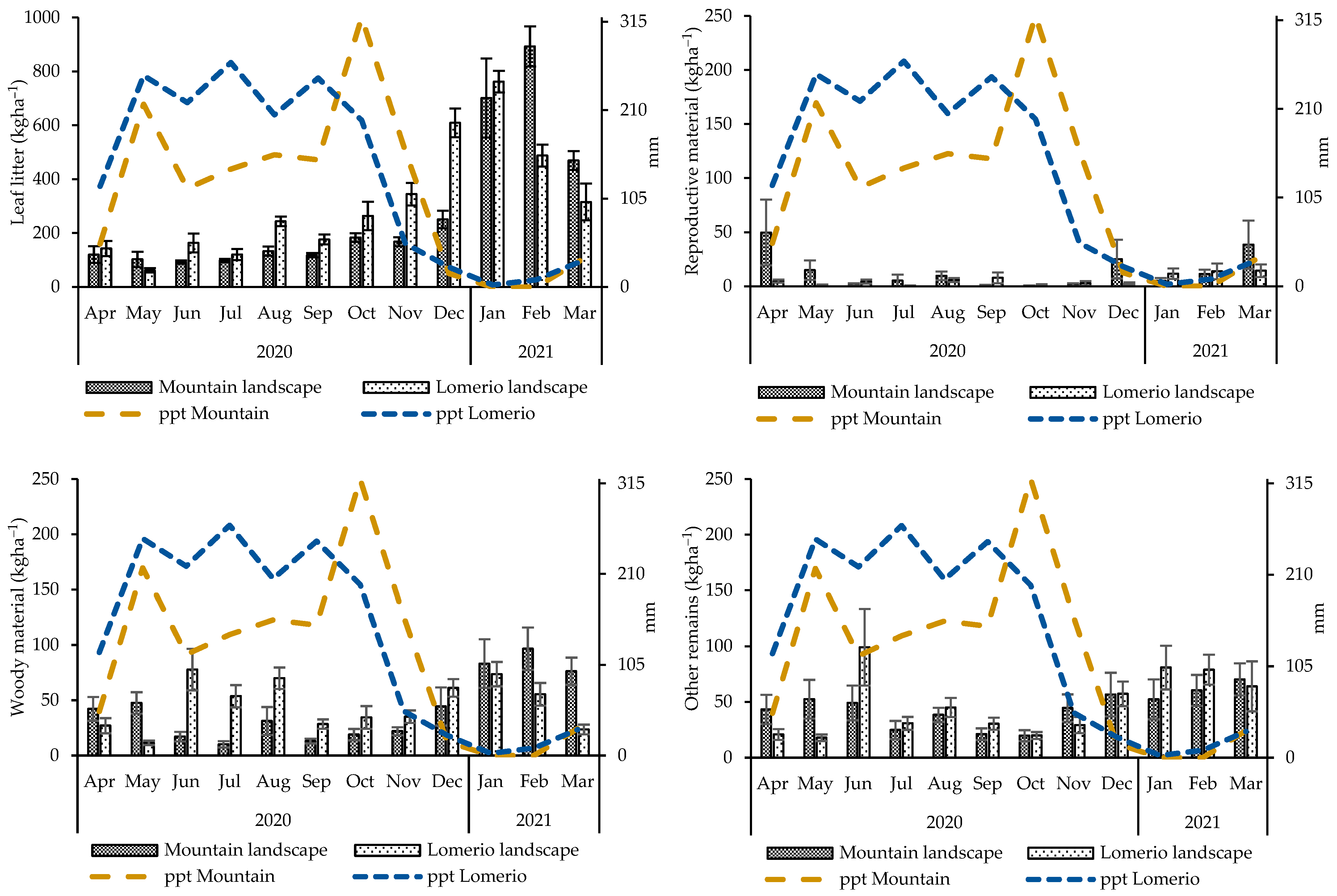
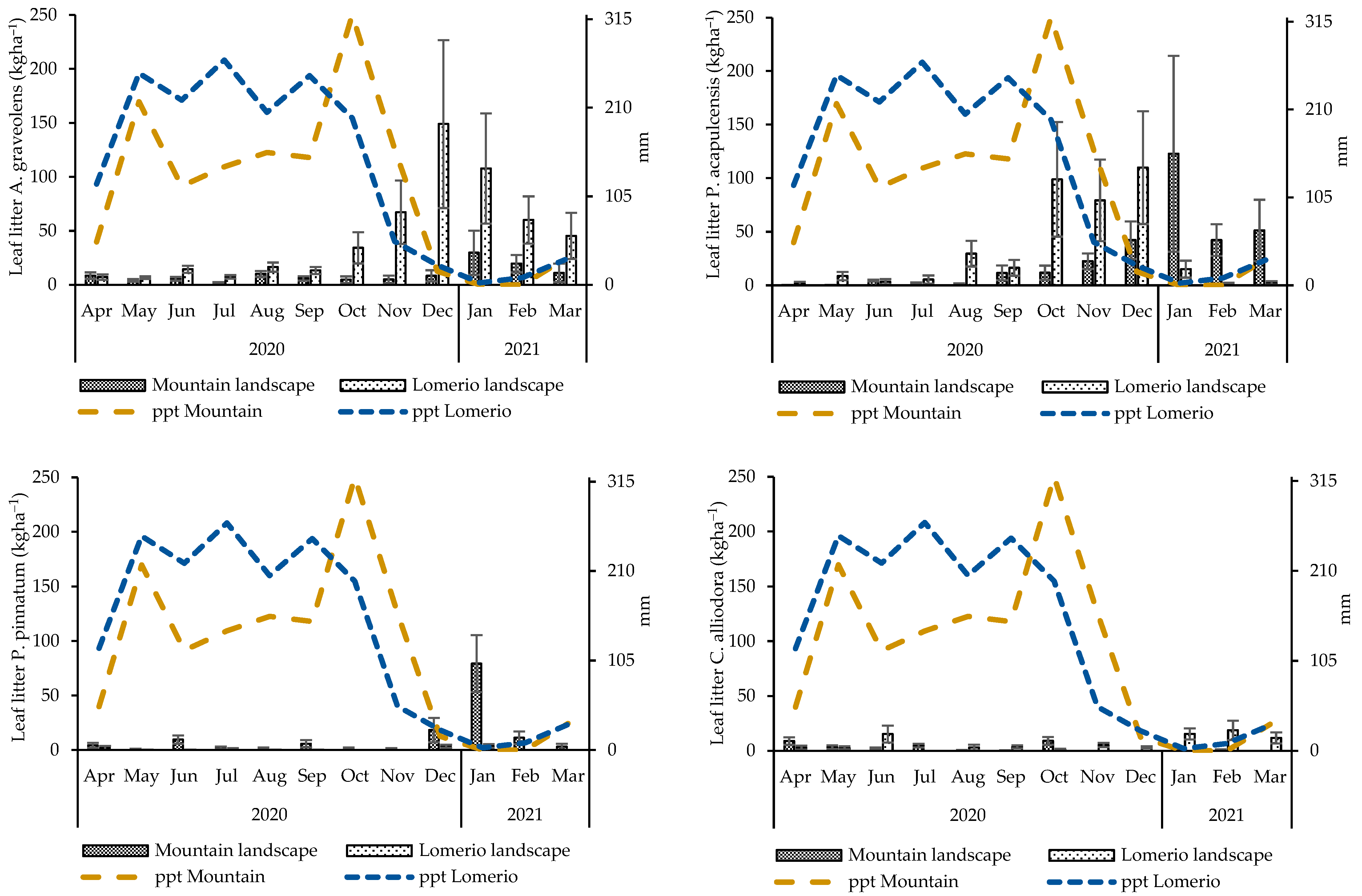
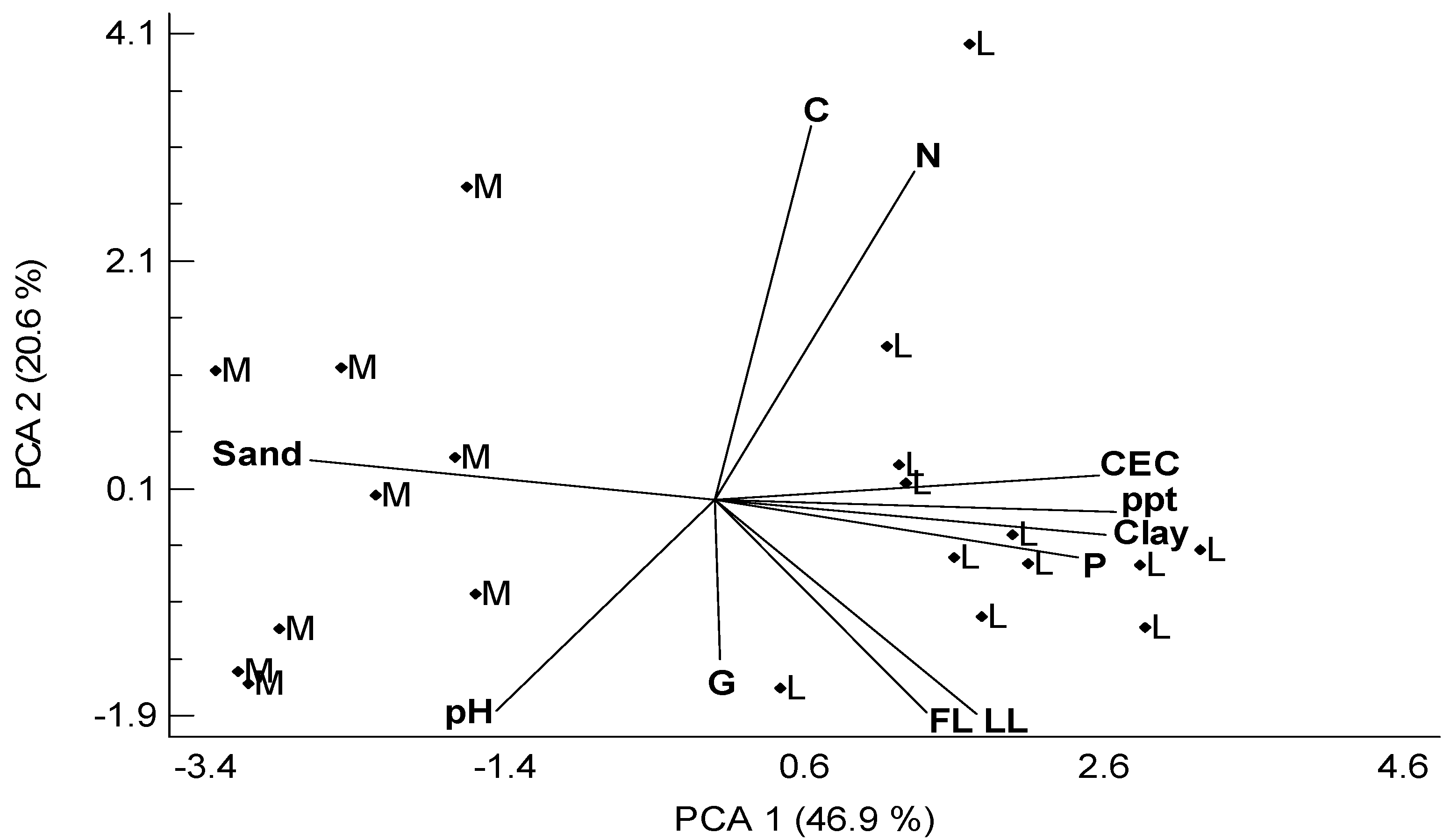
| Parameters | Structural Characteristics | |||
|---|---|---|---|---|
| Mountain Landscape | Lomerio Landscape | |||
| ARA 1 | ARA 2 | PLA 3 | SBP 4 | |
| Age (years) | >40 | >40 | >40 | >40 |
| D (tree ha−1) | 628 ± 49.80 | 444 ± 62.21 | 468 ± 40.99 | 490 ± 50.83 |
| DBH mean (cm) | 21 ± 1.33 | 19 ± 1.24 | 19 ± 1.21 | 20 ± 2.54 |
| G (m2 ha−1) | 26 ± 3.92 | 14 ± 2.10 | 17 ± 2.97 | 20 ± 4.32 |
| H (m) | 11 ± 0.65 | 10 ± 0.74 | 12 ± 1.27 | 11 ± 0.63 |
| Dominant species (IVI) | A. graveolens (27) | P. acapulcensis (50) | C. baducca (68) | P. acapulcensis (55) |
| R. chryseum (23) | M. goudotii (29) | Q. odoratissima (60) | A. graveolens (53) | |
| A. inermis (22) | A. graveolens (17) | A. graveolens (41) | S. mombin (32) | |
| C. alliodora (19) | S. mombin (16) | P. septenatum (17) | A. collinsii (24) | |
| T. oblonga (18) | G. ulmifolia (16) | C. alliodora (13) | P. pinnatum (16) | |
| Soil physicochemical characteristics | ||||
| BD (g/cm3) | 1.5 ± 0.05 | 1.3 ± 0.10 | 1.1 ± 0.08 | 1.1 ± 0.03 |
| Sand (%) | 65.6 ± 1.60 | 64.8 ± 4.07 | 18.0 ± 2.97 | 3.9 ± 1.27 |
| Silt (%) | 18.4 ± 0.74 | 16.7 ± 0.63 | 27.7 ± 1.31 | 22.0 ± 2.40 |
| Clay (%) | 16.1 ± 1.06 | 18.5 ± 3.10 | 54.3 ± 4.08 | 74.1 ± 3.14 |
| pH (1:2) | 6.4 ± 0.50 | 6.5 ± 0.24 | 6.4 ± 0.23 | 5.7 ± 0.10 |
| C (%) | 1.6 ± 0.23 | 1.3 ± 0.15 | 1.9 ± 0.33 | 1.6 ± 0.23 |
| N (%) | 0.2 ± 0.02 | 0.2 ± 0.02 | 0.2 ± 0.04 | 0.2 ± 0.17 |
| C/N | 9.4 ± 11.0 | 8.5 ± 9.7 | 8.1 ± 7.6 | 9.6 ± 1.4 |
| P (mg/kg) | 4.9 ± 0.44 | 5.7 ± 2.42 | 24.1 ± 6.30 | 35.3 ± 4.14 |
| N/P | 400.5 ± 1.23 | 293.5 ± 0.18 | 116.7 ± 0.40 | 56.0 ± 0.12 |
| K (cmol (+)/kg) | 0.2 ± 0.05 | 0.2 ± 0.10 | 0.7 ± 0.14 | 0.8 ± 0.23 |
| Ca (cmol (+)/kg) | 3.2 ± 1.00 | 2.6 ± 0.84 | 12.0 ± 2.50 | 7.8 ± 0.91 |
| Mg (cmol (+)/kg) | 0.8 ± 0.07 | 0.9 ± 0.40 | 7.0 ± 0.60 | 7.1 ± 0.70 |
| CEC (cmol (+)/kg) | 4.7 ± 0.77 | 3.8 ± 0.86 | 19.8 ± 2.11 | 16.2 ± 1.46 |
| Fine Litter Fractions | Landscapes | |
|---|---|---|
| Mountain | Lomerio | |
| Leaf litter A. graveolens | 115.5 ± 38.97 b | 529.9 ± 180.97 a |
| Leaf litter P. pinnatum | 138.1 ± 43.69 a | 10.9 ± 3.48 b |
| Leaf litter C. alliodora | 31.1 ± 7.26 a | 83.5 ± 27.95 a |
| Leaf litter P. acapulcensis | 312.3 ± 85.08 a | 371.7 ± 157.87 a |
| Leaf litter other species | 2733.2 ± 116.97 a | 2698.4 ± 219.85 a |
| Total leaf litter | 3330.2 ± 114.06 b | 3691.4 ± 130.57 a |
| Reproductive material | 164.1 ± 41.54 a | 71.1 ± 18.85 b |
| Woody material | 502.9 ± 31.61 a | 552.2 ± 28.87 a |
| Other remains | 533.4 ± 78.08 a | 574.9 ± 39.21 a |
| Total fine litterfall | 4530.6 ± 175.43 a | 4889.5 ± 160.17 b |
Publisher’s Note: MDPI stays neutral with regard to jurisdictional claims in published maps and institutional affiliations. |
© 2022 by the authors. Licensee MDPI, Basel, Switzerland. This article is an open access article distributed under the terms and conditions of the Creative Commons Attribution (CC BY) license (https://creativecommons.org/licenses/by/4.0/).
Share and Cite
Castellanos-Barliza, J.; Carmona-Escobar, V.; Linero-Cueto, J.; Ropain-Hernández, E.; León-Peláez, J.D. Fine Litter Dynamics in Tropical Dry Forests Located in Two Contrasting Landscapes of the Colombian Caribbean. Forests 2022, 13, 660. https://doi.org/10.3390/f13050660
Castellanos-Barliza J, Carmona-Escobar V, Linero-Cueto J, Ropain-Hernández E, León-Peláez JD. Fine Litter Dynamics in Tropical Dry Forests Located in Two Contrasting Landscapes of the Colombian Caribbean. Forests. 2022; 13(5):660. https://doi.org/10.3390/f13050660
Chicago/Turabian StyleCastellanos-Barliza, Jeiner, Victoria Carmona-Escobar, Jean Linero-Cueto, Eber Ropain-Hernández, and Juan Diego León-Peláez. 2022. "Fine Litter Dynamics in Tropical Dry Forests Located in Two Contrasting Landscapes of the Colombian Caribbean" Forests 13, no. 5: 660. https://doi.org/10.3390/f13050660
APA StyleCastellanos-Barliza, J., Carmona-Escobar, V., Linero-Cueto, J., Ropain-Hernández, E., & León-Peláez, J. D. (2022). Fine Litter Dynamics in Tropical Dry Forests Located in Two Contrasting Landscapes of the Colombian Caribbean. Forests, 13(5), 660. https://doi.org/10.3390/f13050660







